The best term to define Siena is "unique".
Unique for its beauty enclosed in a small historic center. Unique because the colour of its ancient buildings has a name: "terra di Siena" (Siena's soil). Unique for the passion that the Sienese give to the symbolic event of the city, the Palio.
In this article, we are shearing 10 tips to explore Siena like a true local. Enjoy!

What to do in Siena like a local
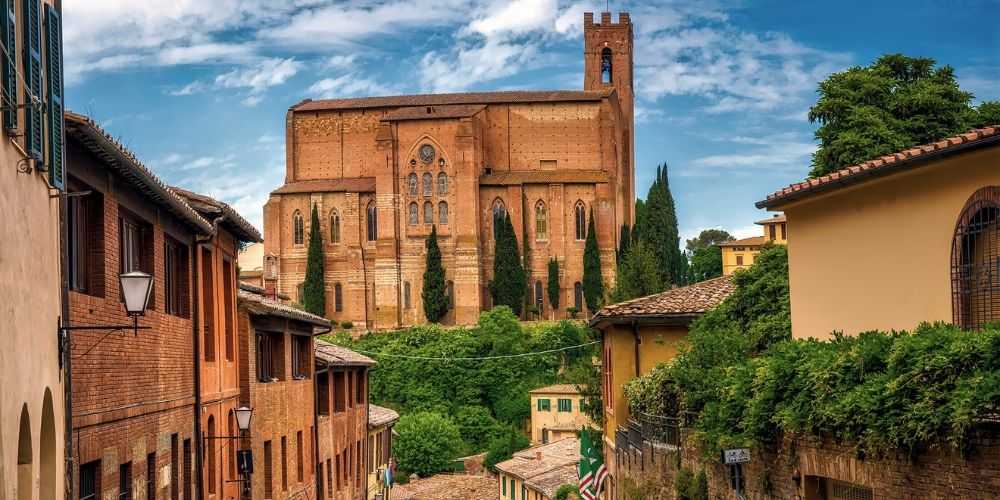
The Golden Age of Siena is in the heart of the Middle Ages, when it rivalled with Florence in beauty and prosperity and when it alone challenged the armies of the Empire.
All this wealth has left its mark on the palaces and folklore of the locals.
But apart from the world-renowned landmarks like Piazza del Campo, the Duomo and the Baptistery there is a small microcosm to discover.
The following is therefore the list with our suggestions to make you experience the city like a genuine Sienese, to discover those little gems that make a visit special.
Here are the 10 things to do in Siena to experience the city like a local: let's discover together the traditional dishes not to be missed, the panoramic point for a bird-eye view and how to watch the horse race warming the hearth of the locals.
Visit Siena and its historic centre10. What to do in Siena like a local. A tasting session of local wines

Siena is surrounded by rolling green hills, famous all over the world.
The city is bordered to the north by the Chianti hills, while the Val D'orcia and the Crete Senesi close the circle to the south: these hilly areas are perfect for growing vines and have been producing world-class wines for years.
So if you love wine you are in the right place.
Red wines such as Brunello di Montalcino and Chianti, or whites such as the Vernaccia di San Gimignano are just some of the most popular ones.
To taste local wines within the city walls, just choose one of the many wine bars (“enoteca”) in Siena: we recommend the Emporio Mediterraneo (also excellent for local products such as honey) and the Cantina del Brunello di Montalcino, almost a town landmark.
You can also book a wine tasting right in front of the Siena Cathedral, the perfect setting if you stay in the city.
On the other hand, if you prefer to get out of the city and visit a winery to taste local award-winning wines, you can join a half-day tour in the Brunello di Montalcino area.
Whatever you chose, we are sure that Siena won’t disappoint you.
Book the Brunello wine tour9. Relax at the local garden
There is a green and relaxing spot to enjoy a moment of peace in the heart of Siena: it is the Orto de' Pecci, a few hundred meters from the Torre del Mangia.
The "orto" in Italian is half way between a garden and a vegetable garden.
Behind the calm of this place there is a dramatic story: in the Middle Ages the road that crossed the area was used by those sentenced to death to reach the place of executions.
Here were built a few houses and a mill while planning for the city expansion. Unfortunately, the plague that struck Siena in 1348 halted the growth of the city, making these houses useless. They were razed to the ground to create vegetable gardens. After the 16th century, these gardens were used by the inmates of the local mental hospital to support themselves and for occupational therapy.
This area of the city is a mute witness of what Siena could have become without the severe blow inflicted by the plague epidemic.
Today the Orto de' Pecci is a tiny urban oasis where you can breathe in the scents of plants and herbs, walk among the animals as if you were in the countryside and eat the excellent local dishes in the local restaurant. The garden is is managed by a cooperative that helps people with disabilities.
This chilled garden is highly recommended if you want your children to play or rest, but also if you want to let them know the secrets of agriculture and nature thanks to the educational events organised by the cooperative.
8. What to do in Siena like a local: climbing the city tower

The journey through Siena like a local starts from the top.
The view above Siena from the Torre del Mangia will leave you breathless.
This civic tower is the symbol of Siena and stands out over Piazza del Campo and the picturesque red roofs of the city.
From the top of the Torre del Mangia you can clearly appreciate Siena’s ancient buildings, the green surrounding countryside and - on clear days - you can also spot Monte Amiata in the distance.
Opened in 1348, the tower is about 88 metres high and reaches almost the same height as the bell tower of the local Cathedral, as if to signify a balanced truce between temporal and spiritual power.
The name of the tower comes from the nickname given to the old bell ringer, called "Mangiaguadagni" (in English “earnings-eater”) for his ability to squander money. Although the role of the bell ringer has been replaced by a clock, the Sienese are fond of the nickname and have kept it for the tower.
It takes about 10 minutes to get to the top, climbing over 300 steps (some of them are slippery and uneven) and passing through several bottlenecks. The climb is not difficult as long as you are careful where you put your feet, but it will test your cardio.
Tickets cost around €10 but there are discounts for children and families. We recommend combining a visit to the tower with a visit to the splendid Palazzo Pubblico.
If you are a university student, be aware of a local legend that says that whoever climbs the tower will fail to graduate: maybe it's just folklore, but it's good to know this before planning a visit…
7. Eat in a traditional restaurant
.jpg)
Eating in Siena is an unforgettable culinary experience.
The best way to experience the city like a local starts right at the dinner table.
The city centre of Siena offers top-notch restaurants, osterie (“inns”) and taverns, where you can eat traditional dishes and enjoy the lively atmosphere. But Siena also boasts eateries serving Sienese street food - above all the focaccia called "ciaccina" and the typical sandwiches with cold cuts and Tuscan cheese.
There is so much to try in the tavern, from fine cuts of meat to richly flavoured soups, ending with the famous Sienese desserts.
The best-known first courses are certainly the pici (large spaghetti made with soft wheat flour and seasoned with cheese and pepper sauce, meat sauce or with aglione, a local garlic sauce) and pappardelle with wild boar or hare ragù.
Winter is the perfect time to enjoy ribollita. The ribollita is a hearty soup made with stale Tuscan bread, black cabbage, potatoes and beans: after exploring the city in the cold winter, a plate of ribollita will bring you back to life!
If you opt for just getting the second course, you have a wide choice: we recommend the unmissable beef T-bone steak and all the succulent meat cuts of Cinta Senese, a local breed of pig reared in the wild.
To end the meal with a dessert, play it safe and order the typical cantuccini biscuits with vin santo (“holy wine”), or try the Ricciarelli biscuits. At Christmas, you must try the Sienese panforte, a local specialty known since the Middle Ages and prepared with almonds, candied citrus peel, honey and lots of spices.
Panforte and Ricciarelli are the perfect souvenir to take home after a visit to Siena: the pastry shops and bakeries of the city have plenty on display, especially around Christmas time.
Find more about food and wine tour in Siena6. Spend a day at the spa

Siena is a stone's throw from different popular spas.
The two most popular spas villages near Siena are Rapolano Terme and Bagno Vignoni.
Loved by both locals and tourists alike, they guarantee a day of relaxation in the splendid Sienese countryside, and a panacea for body and spirit.
The village of Rapolano Terme stands in the middle of the rolling Clay Hills of Siena and was known in the past for two reasons: its rich travertine quarries and its sulphurous waters.
Here the thermal waters flow at a temperature of about 39° and are a blessing for those suffering from rheumatism, arthritis and respiratory tract disorders.
Visitors looking for a wellness holiday can choose from two well-established thermal baths: the Terme San Giovanni (fantastic for a night at the spa and with a beautiful panoramic view) and the Terme Antica Querciolaia (with indoor and outdoors pools and a wide range of wellness services).
On the other hand, the tiny village of Bagno Vignoni has been on the map for "thermal tourism" since Roman times, thanks to the fame of its curative waters.
This spa is close to the Via Francigena (connecting Canterbury to Rome) and was therefore a resting place for pilgrims en route to Rome.
The uniqueness of Bagno Vignoni is the sixteenth-century pool in the main square of the town, built right above the original source of thermal water. Surrounded by mediaeval buildings, the 49-metres long pool is filled with hot spring water. You cannot bathe in it, but fear not, Bagno Vignoni offers a valid alternative to bathe for free.
Head to the Parco dei Mulini, consisting of several free pools. The water here is channelled directly from the hot pool in the square and it's slightly colder (but still enjoyable). There are no changing rooms or bathrooms, so keep this in mind when visiting the free thermal baths.
5. Go for an aperitivo in the city centre
Aperitivo is an integral part of Italian culture.
Siena certainly does not hold back when it comes to a classic pre-dinner drink.
You'll discover excellent wines from local cellars (such as Brunello di Montalcino, Chianti, Vernaccia), chicken liver croutons, tasty cheese platters (with multiple types of pecorino) and traditional cured meats, such as the famous Cinta Senese or finocchiona salami.
There are several areas in Siena where to head for an aperitivo after 5pm.
Via S. Pietro, for instance, takes you south from Piazza del Duomo: here you’ll find some nice spots for a drink, such as the Vineria Tirabuscio’ with its welcoming atmosphere and a large selection of local wines (including organic ones).
One of the most popular street among the Sienese is the narrow and charming Via Camollia. Here there are many bars and restaurants offering various types of aperitifs. We recommend Il Cantiere del Gusto, with craft beers and tasty platters.
Finally, the touristy area around Piazza del Campo is full of wine bars where you can explore the alcoholic aspect of the local gastronomy: the quality is always very high, so if you don't know which one to choose, ask the locals and trust their taste.
Find more about tastings in a Siena vineyard4. Siena like a local: partecipate at the most famous Palio in Italy
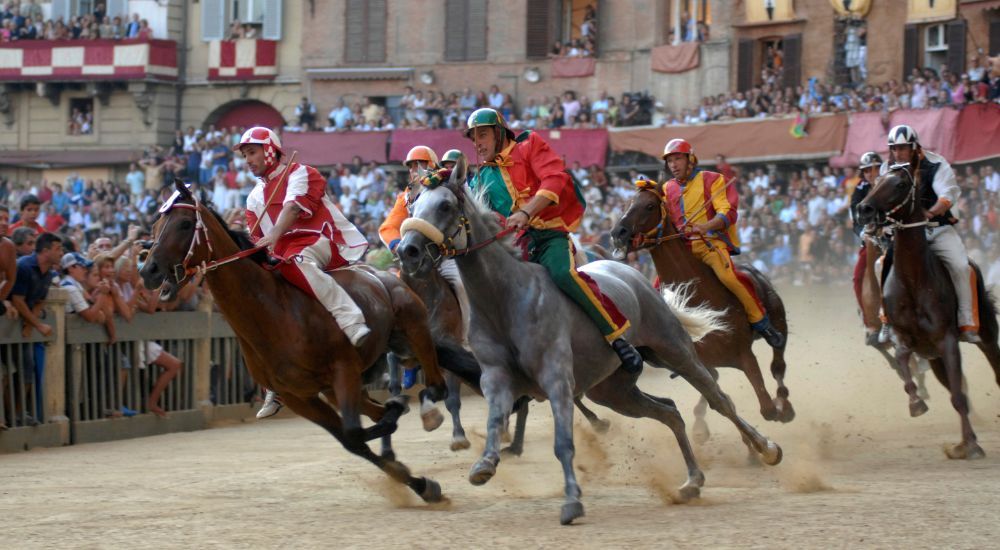
Tense, ferocious, spectacular.
The Palio di Siena is much more than a simple horse race: it’s the pinnacle of the rivalries between the districts of Siena (called "contrade").
Everything in the city revolves around this horse race, an adrenaline-packed carousel born in the Middle Ages and whose appeal never fades.
The Sienese participate in the event with passionate cheering: tourists and visitors must show respect and neutrality. For foreigners it’s difficult to understand the importance given by the Sienese to this competition, and the only way to grasp it is to spend a few days in the city during the event.
The contrade of the city go to battle in this horse race twice a year (July 2nd and August 16th). 10 districts out of a total of 17 participate in the competition and rotate every year, with their heraldic coats of arms and ancient names (such as Aquila, Drago, Chiocciola, aka “Eagle”, “Dragon” or “Snail”).
The horse that crosses the finish line first after 3 laps wins the coveted “Drappellone” (“the big banner”), called “cencio” by the Sienese. The 1000-metre track is specially set up in Piazza del Campo, with dangerous and breath-taking turns.
Each of the two Palio lasts 4 days - many test races are held before the highly anticipated final race. But in Siena the Palio lasts all year round, due to the rivalries between the districts and the parties organised by the locals on many occasions.
Attending the Palio from Piazza del Campo is free but you have to arrive 3-4 hours in advance to get some space. The square is made in the shape of a shell and guarantees a decent visibility.
The paid seats are those on the boxes or on the terraces of the apartments overlooking the square. Ask the locals to buy tickets as there is no official ticket office. It is important to remember that Piazza del Campo is crammed to capacity for the race, so the experience could be stressful if you are not fond of crowds.
If you are interested in these privileged seats, you must book in advance for the competition and also for the district dinners, where you can get a glimpse of the enthusiasm of the local people and understand the importance of the event.
We also recommend bringing water and snacks with you, as well as a hat, due to the high summer temperatures.
Staying in Siena during the weeks of the Palio is the ideal way to appreciate the event but remember that accommodation prices are higher than normal and demand is very high.
3. Discover a tiny hidden detail
It's not exactly a local activity, but this curious and little-known detail of Siena will surely surprise you.
Head to Via di Città, one of the old town's most beautiful and elegant streets. It connects the Duomo to Piazza del Campo and is lined with monumental residences steeped in the city's history. Examples include Palazzo Patrizi, the prestigious seat of the Accademia degli Intronati since the 16th century, and Palazzo Piccolomini, which houses the Centre for Contemporary Architecture.
As you stroll, you'll reach the intersection with Piazza Quattro Cantoni, a lively gathering place for the local aristocracy until the 17th century. Elegant palaces sound the piazza. It's one of these that you need to scrutinise closely: spot Palazzo Chigi-Saracini and focus your gaze on the first floor.
You'll notice an unexpected detail on the right: a tiny shutter. The Municipality of Siena has dubbed it the "Smallest Window in the World". While no one has verified the actual correctness of this claim, we can assure you it honestly seems Smurf-sized!
2. Explore the nearby towns
Siena is enchanting, and that's a given. But its province is equally captivating. The rolling landscape, dotted with olive and cypress trees, and the villages with their medieval skylines provide the perfect backdrop for a day trip just a short distance from the city.
But where to go? The choices abound. You can stop by Montalcino, Montepulciano, or Bagno Vignoni, visit the Abbey of San Galgano and capture photos of the famous cypress trees in San Quirico d'Orcia.
In San Gimignano, the New York of the Middle Ages, you can stroll among ancient towers and sip Vernaccia, feeling transported back in time.
In Monteriggioni, a village with mighty circular walls along the Via Francigena, you'll discover the settings that inspired the popular video game Assassin's Creed.
Pienza, whose historic centre is a precious UNESCO World Heritage Site, unfolds gracefully amidst palaces and churches that brought Pope Pius II's urban utopia to life. Once you're here, it's imperative to sample the local speciality: pecorino cheese.
Find more about Siena neighbourhood1. Find your way around Siena’s contrade
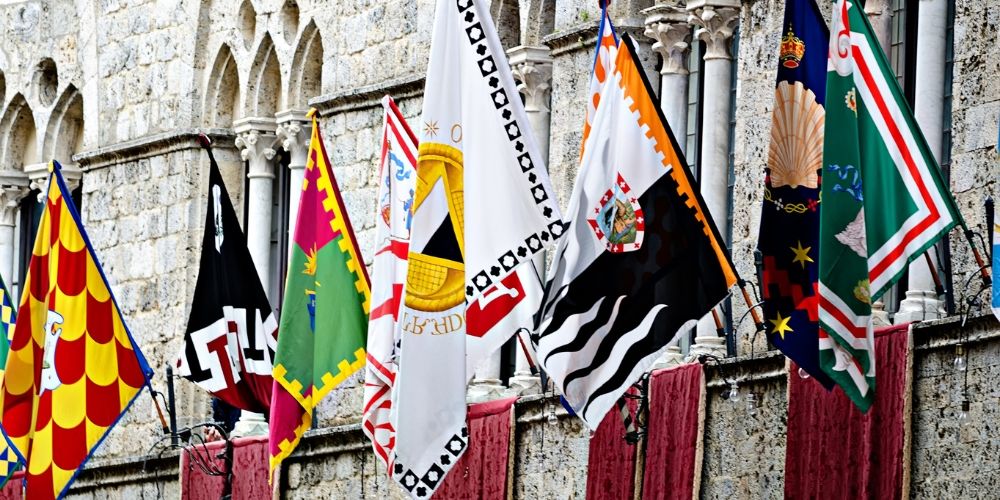
Siena is divided into 17 contrade, the historic neighbourhoods where the sense of identity and belonging among residents is deeply rooted and felt.
But how do you know which one you're in as you wander through the city? There are some tricks to help you navigate.
Firstly, look out for the coats of arms on the walls of the buildings placed between districts. If you can't spot them, then pay attention to the fountains scattered throughout the streets.
You'll notice that some depict particular figures, like an eagle, an elephant, a she-wolf, or a tortoise. Others bear mottos or reproduce symbolic and evocative images. As you might have guessed, each symbolises the specific contrada it belongs to and can be used as a sort of GPS.
One of the lesser-known aspects of these fountains is a unique custom associated with them. It's like a secular baptism, a rite of passage for the young Senesi. As they are "baptised" with the water flowing from these sources (ceremonies are held once a year), they become true contradaioli!
About the author
Written on 07/02/2024

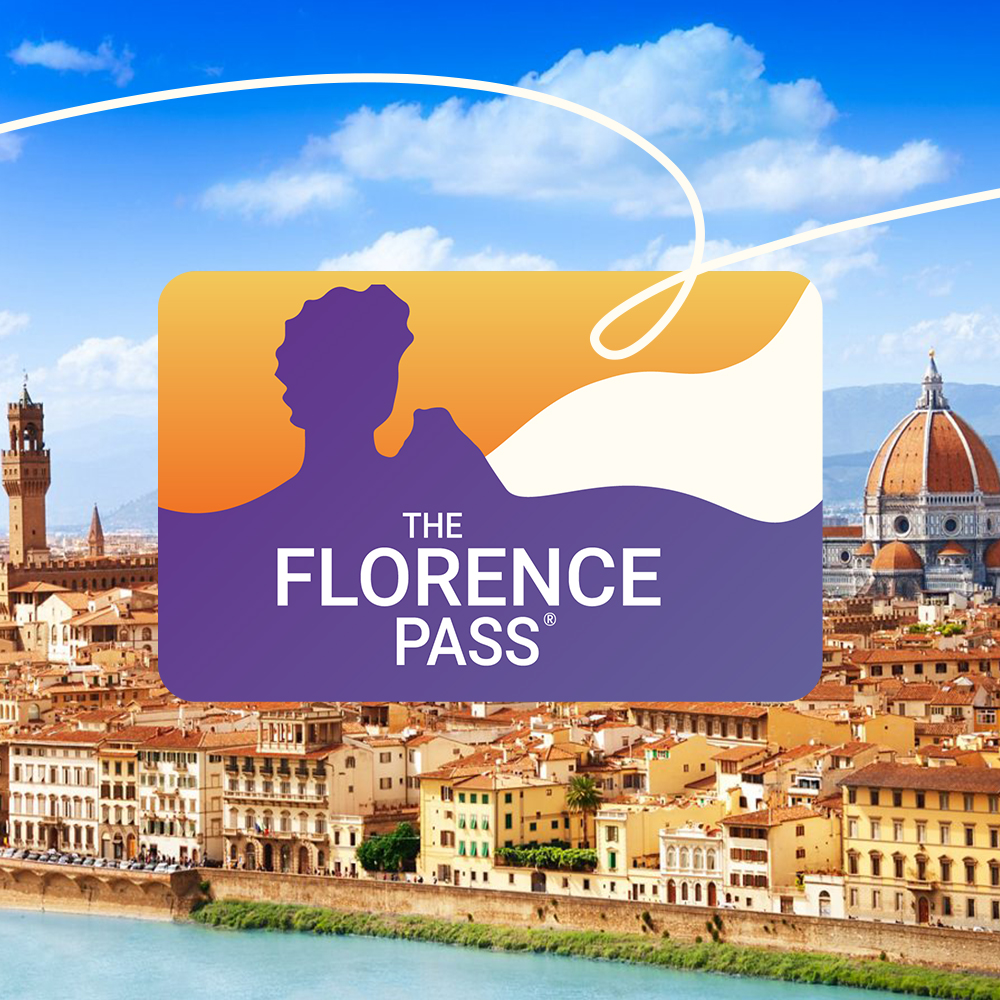
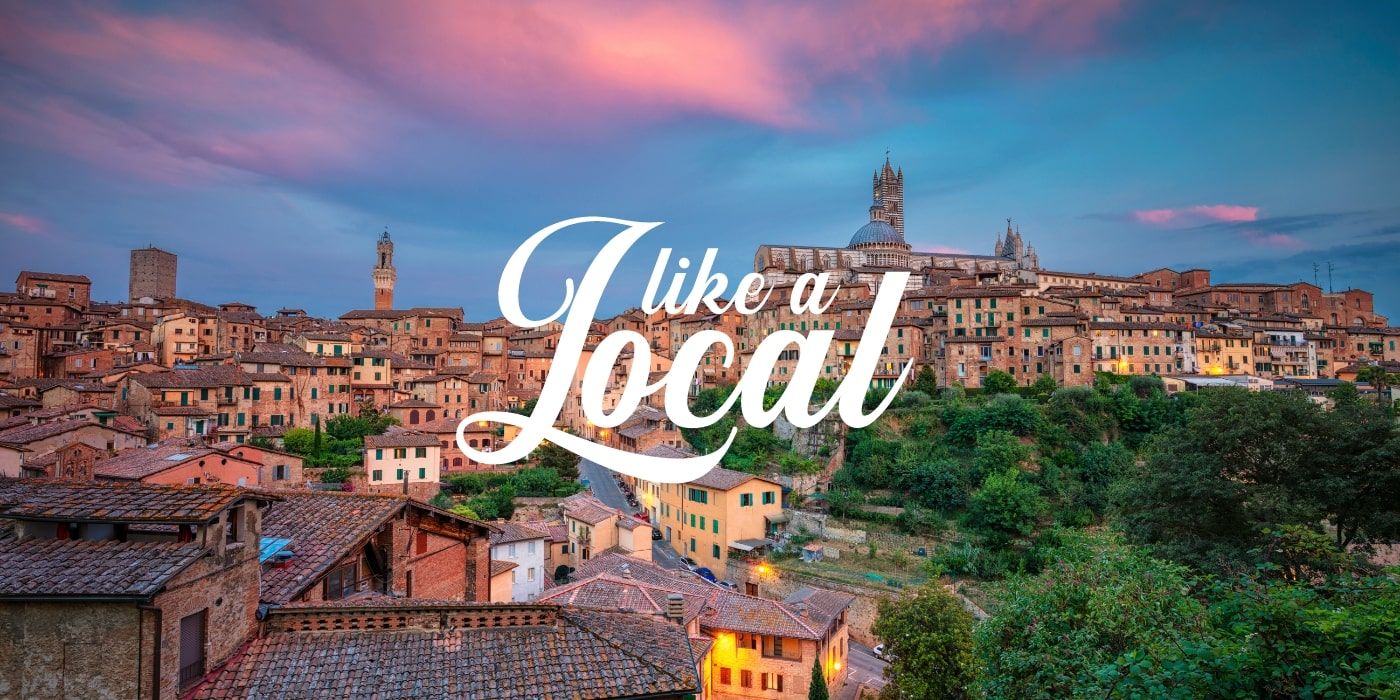

Fabrizio Mariani
Do you want to visit Siena like a local? Then check out 10 things to get the best out of the city.